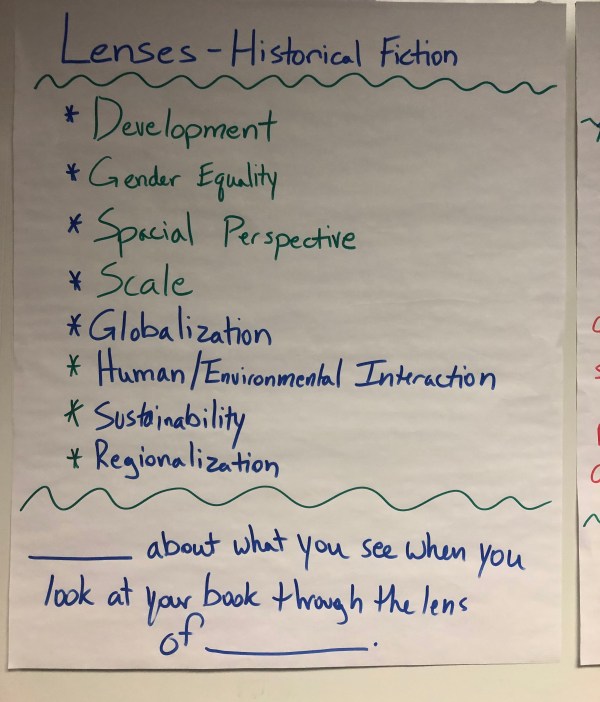 Like so many teachers blessed with a growth mindset, there are always several ideas bouncing around my head that, if realized, might temporarily satisfy my constant need to innovate my teaching practice. Hopefully, new moves and ideas lead me toward maximizing the delivery of instruction and the transfer of learning. Heading into the TCTELA convention back in January, my head was like a Dumbledore’s pensieve, ideas swirling like memories.
Like so many teachers blessed with a growth mindset, there are always several ideas bouncing around my head that, if realized, might temporarily satisfy my constant need to innovate my teaching practice. Hopefully, new moves and ideas lead me toward maximizing the delivery of instruction and the transfer of learning. Heading into the TCTELA convention back in January, my head was like a Dumbledore’s pensieve, ideas swirling like memories.
My sophomore classes had been building towards a persuasive essay major grade and their writing showed me that they needed some direct instruction centered on the elements of argument: claim, evidence, and commentary. Instead of focusing on the persuasive task from the outset, we worked hard on building arguments and then we “bent” our writing towards persuasion at the last moment.
Reflection on the genesis of this move points my thinking towards the argument writing that is so often the learning focus of my AP Lang classes and the learning progression of authentic writing instruction that focuses on the process rather than the end task.
Last year, I learned how writing can focus on specific, foundational elements that we practice over and over, gradually increasing the complexity of the task up to the point that the data tells us that the learners are ready to put their newly developed skills on display. In this philosophy, the publishing piece is merely a chance to showcase our writing prowess and highlight our growth as writers. I hear over an over that we should teach the skills, not the essay. We should teach the student, not the subject. This is my “how.”
Each lesson cycle circled through a routine that included deep dives into the skills we see demonstrated in mentor texts. At a recent campus professional learning session, I got to learn more about teacher clarity. Specifically, I can be more clear in designing the learning intentions if I understand the skill and teach to the level of the standard. It was an effort to approach our state standards, the TEKS, that helped me determine which parts of a mentor text we would magnify and dissect. Hopefully, that sentence level instruction will support our reading comprehension in addition to increasing the effectiveness of our writing.
Each lesson cycle blended reading and writing, providing multiple opportunities for both. I started each lesson by reading the mentor text aloud, and students only had one task: circle words you don’t know. After the brief read-aloud, we would take three minutes for a quick write connected to a big idea from the text. Each quick write starts with “write about a time…” so that we tell real stories from our lives that we might be able to use as concrete evidence when we approach argument writing tasks at a later time. Before digging back into the mentor text, we would take a few moments to review the words we didn’t know and to look for the “big ideas” that we noticed while we were reading. I’m obsessed with readers seeing the “big ideas” in what they are reading because I believe it helps us recognize arguments, and maybe we can support our arguments with textual evidence if we make the connection.
After working through the mentor text, we would look at an argument prompt that forced us to take a position. This was a chance for us to practice our argument writing every day for between ten and fifteen minutes, and we could share our ideas with other writers in the room so that we could give each other feedback. We took a position and defended it every single day. At first, some of us struggled with the surface level skill of deciding on a position while others struggled with providing concrete evidence to support their claim. That’s one of the difficulties about writing instruction: we are all in different places. A class of twenty writers are going to be in twenty different places in their learning progression, and we have to be ready to teach to the standards while scaffolding for our writers who find themselves struggling. By lesson seven, the writers looked forward to flexing their argument muscles and eagerly dove into the writing tasks. We still encountered struggle, but our newfound skills gave us the confidence to attack those struggles without fear.
This unit asked writers to work hard and switch back and forth between reading and writing, blending literacy skills in a way that demanded significant effort from the students. The lessons were organized so that the students would have to move quickly between tasks, linking their reading and writing. This work is not easy and sometimes the students find gaps in their capabilities that cause them to react negatively. Teachers must balance high expectations with an awareness of students’ needs. They deserve it. They crave it. They embraced the process.
Charles Moore is a father, teacher, writer, and obscure pod-caster. He’s starting to get his pool ready for warmer weather and kicked off the crawfish season in peak form. In May, he will receive his master’s degree in curriculum and instruction from the University of Houston.


 Taking one paragraph each from the sample essays, we read them like writers and explored the decisions and moves made by those writers. Our process of discovery put the cognitive load on the students and allowed me to serve as a “tour guide.” We learned how our argument skills can be applied to this specific writing task, finding new words to add to our personal dictionaries and use in our own writing. We debated the use of claim and evidence and the utility of being intentional with the length of the direct evidence we blend into our argument. We examined the sentence structure decisions made by the writers and noticed how combining sentences can make our writing, and our argument, clearer.
Taking one paragraph each from the sample essays, we read them like writers and explored the decisions and moves made by those writers. Our process of discovery put the cognitive load on the students and allowed me to serve as a “tour guide.” We learned how our argument skills can be applied to this specific writing task, finding new words to add to our personal dictionaries and use in our own writing. We debated the use of claim and evidence and the utility of being intentional with the length of the direct evidence we blend into our argument. We examined the sentence structure decisions made by the writers and noticed how combining sentences can make our writing, and our argument, clearer.
 Wrapping up the “back to work” week left me feeling energized and excited for the new school year to start. I’m teaching two new preps, sophomores and AP Lang, and, whereas in the past looking a blank calendar spiked my anxiety, last week my mind danced with literacy possibilities.
Wrapping up the “back to work” week left me feeling energized and excited for the new school year to start. I’m teaching two new preps, sophomores and AP Lang, and, whereas in the past looking a blank calendar spiked my anxiety, last week my mind danced with literacy possibilities. Our back-to-school schedule included many of the typical, district-mandated informational reviews. It was obvious that our administrators did their best to keep that time from dragging or being wasted, and for that, I am grateful.
Our back-to-school schedule included many of the typical, district-mandated informational reviews. It was obvious that our administrators did their best to keep that time from dragging or being wasted, and for that, I am grateful.

 Shout by Laurie Halse Anderson
Shout by Laurie Halse Anderson For Every One by Jason Reynolds
For Every One by Jason Reynolds I loved Truly Devious for so many reasons. Massive and mysterious Gothic mansion setting? Check! Plucky and intelligent teenage sleuth? Check! Fast paced narrative that weaves in authentic “teenager sounding” dialogue? Check! This sequel is a win for everyone involved and I can’t wait for the final book in the series!!
I loved Truly Devious for so many reasons. Massive and mysterious Gothic mansion setting? Check! Plucky and intelligent teenage sleuth? Check! Fast paced narrative that weaves in authentic “teenager sounding” dialogue? Check! This sequel is a win for everyone involved and I can’t wait for the final book in the series!!
 Two Can Keep a Secret by Karen McManus
Two Can Keep a Secret by Karen McManus A Very Large Expanse of Sea by Tahereh Mafi
A Very Large Expanse of Sea by Tahereh Mafi Wolf Pack (Joe Pickett, #19) by C. J. Box
Wolf Pack (Joe Pickett, #19) by C. J. Box 







